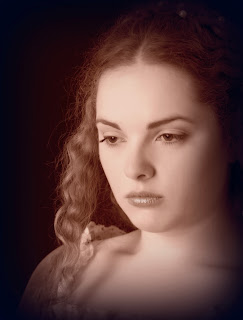Those who read my Legacy of the Queen of Scots series know who Daisy Kirkcaldy is. She is the indomitable posthumous bastard daughter of the Knight of Grange. He is a real historical character, but she is not. Sometimes I pretend she is my alter ego, but she is not that, either. I know this, because, in my book 1603, the story begins with everyone who matters telling her to get on with her life because her husband Will Hepburn is dead, and she refuses to believe them. In my novel, Daisy is right, and the rest of the world is wrong. I would not have had her faith in Hepburn or her inner strength.
But then, this morning--a beautiful desert morning unique to the high desert after a storm--I awakened knowing as long as I do not write it, Hepburn and Daisy will live without either of them having to share the death of the other. Such is the way of fiction. Life is different. But, I asked myself, what if Will should die on one of their madcap adventures under circumstances disallowing Daisy to deny the reality of Will Hepburn's death?
What then, Daisy Kirkcaldy?
I think of another pair of star-crossed lovers from the history of Britain both of them real. Like Will and Daisy, they do not alway act wisely or in their common interest, but their love is enduring and intense. And one of them, the more selfish of the two perhaps, out-lived the other for many years. Her name was Sarah Churchill, the wealthiest dowager in Britain, who even in old age was besieged by young, ambitious suitors. But Sarah did not waiver. Legend is she drove them off telling them she would never give in marriage the hand that touched hands with John Churchill, Duke of Marlborough. Methinks Daisy would behave in the same manner.
 |
| John Churchill - First Duke of Marlborough |
When I introduced them in my novel The Other Daughter, I rather expected Daisy to chose her nephew, Andrew Ker of Ferniehirst.
 |
| (PD-Art) |
In addition, there is the problem of consanguinity. Even today, avunculate marriages are not universally considered incestuous, but they are illegal in England and Wales, for example. During Daisy's day, the Pope gave dispensations to Hapsburgs when it was of dynastic advantage for uncles to marry nieces or aunts to marry nephews, but I find no such practice endorsed by the Calvinist Scottish Kirk.
William Hepburn is also real--the bastard son of Lord James Hepburn, Earl of Bothwell, third husband of the Queen of Scots. His mother is either Janet Beaton or Anna Trondsen. History has little to say about him other than he was James VI's browdinstair- an embroiderer of the canopies that hung above the king's place at the banquet table. He also had served as arbitrator in a street brawl. In choosing Hepburn, I had an almost empty slate to fill. But I am not sure I am the one who selected him. I suspect Daisy did.
In my current works in progress (WIPS in novel speak) Daisy is in her early thirties. If she were a modern twenty-first-century woman, she would have another forty years before she faced the crisis that at 76, I am facing now. Her time with Hepburn likely would have been much shorter.
Modern women with permanent partners may not be as financially and socially dependent as their 17th Century counterparts. We have options. They do not make it easier to watch the breath grow shallow, or the eyes grow dim in one we love. Daisy suggests rather than becoming maudlin, I should switch my genre to historical romance and send her, Hepburn, and the kids, on a voyage into a painted sunset, heading somewhere warm, mayhap Bermuda. I wish they had room aboard La Belle Ecoassaise so I could write a place for Chris and me aboard their carrack.



A touching post, a beautiful depiction of that greatest of gifts, love - and of how vulnerable it leaves us to the loss of our other half. I am thinking of you - and Chris.
ReplyDelete